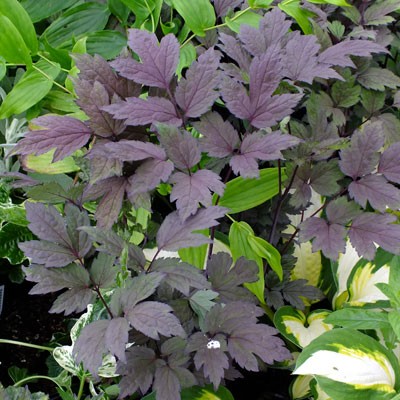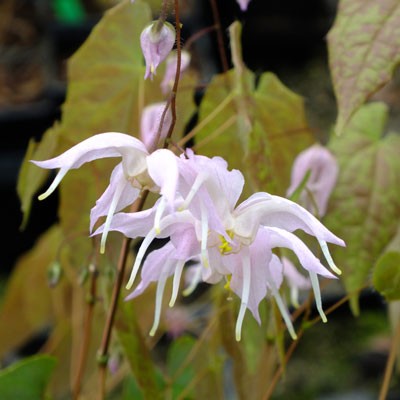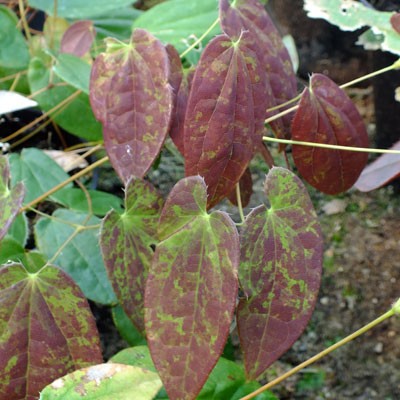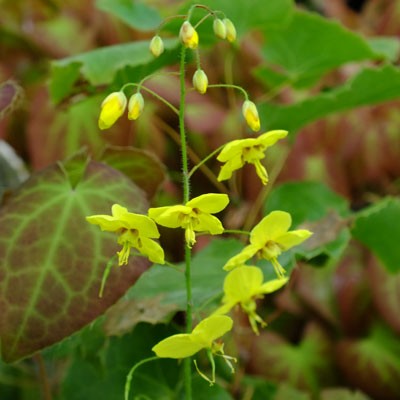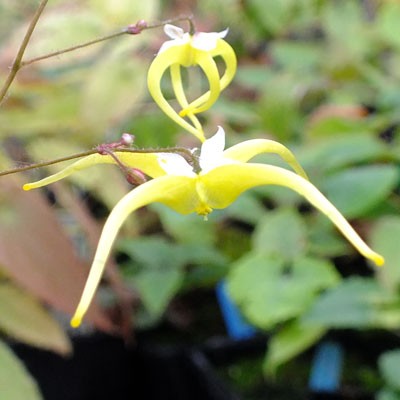-
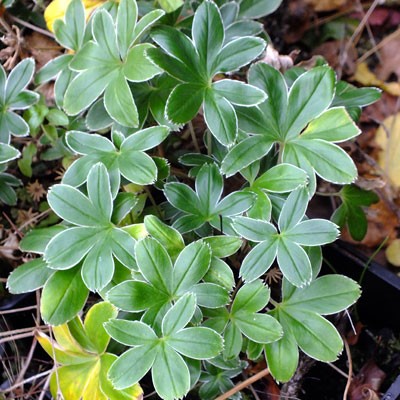
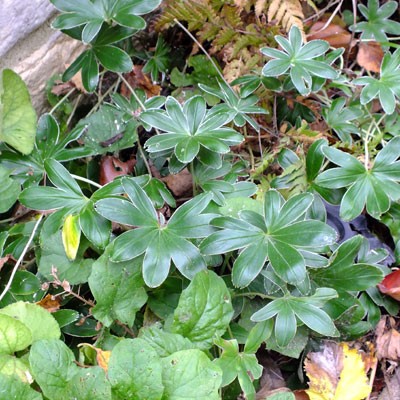
Potsize - 1L
A very neat, refined version of Ladies' Mantle with small neat foliage shaped like a rounded seven point star. The leaf edges are picked out in silvery hairs. The sprays of pale green flowers have distinctive calyces, lending the flowers a spherical texture. Smaller and less rambunctious than its cousin Alchemilla mollis but with similar charming flowers that make such a lovely foil to other flowers, both in the garden or in a vase. Easier to grow than the similar Alchemilla alpina, under whose name this is often sold, which really demands alpine conditions with perfect drainage.Links
Alchemilla in the Garden
-
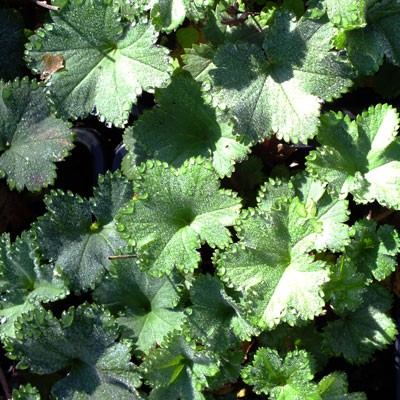


RHS AGM
Potsize - 1L
A smaller form of the otherwise similar Alchemilla mollis with beautiful scalloped, serrated edged foliage which often takes on a blueish-grey hue. Typical chartreuse sprays of flowers are produced in Summer on purply stems and act as a lovely foil to other blooms. Grows about 6 inches high and 8 inches wide and, apart from needing sun for at least part of the day, is very undemanding.Links
Alchemilla in the Garden
-
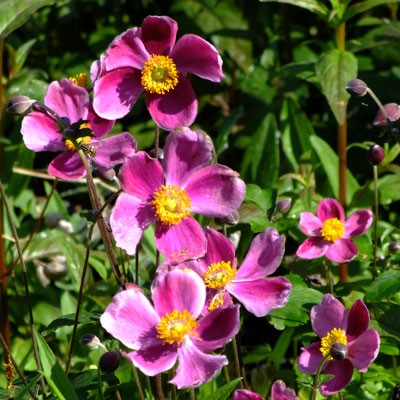

Potsize - 1L
Large 5-petalled flowers of a rich pink, the outermost pair a much stronger hue, like velvety crimson. A boss of bright orange-yellow stamens completes the effect. Height to 90cm. Late Summer-Autumn. The flowers of this variety exhibit the same slightly lopsided character as in the related Hellebores three of the petals are true and the two are in fact petaloid sepals. Discount of 25p per plant for quantities of 3 or overLinks
Anemone Compared
Botanical Style Photographs
-
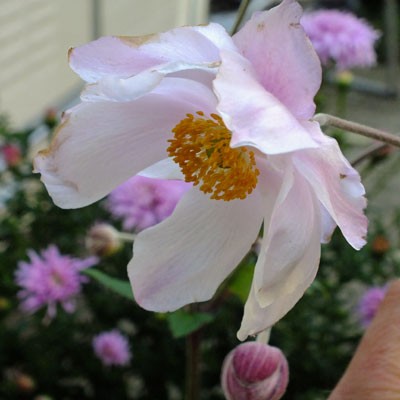

Potsize - 1L
A real beauty with semi-double very large flowers of lovely shape and form. It is almost white suffused with soft rose-pink, becoming stronger flushed and edged on the reverse. Each flower has 12 individual petals which are arranged with great fineness, particularly beautiful when viewed from behind as the rich colouring is most apparent and you can best appreciate the way the petals curve and arch a bit like a waterlily. Tall and robust. Loreley was a Siren who sat on a granite outcrop near the town of St. Goarshausen in the Rhine Valley. From there she would lure passing sailors with her song. So bewitched they would ground their ship and perish 'neath the waters. Discount of 25p per plant for quantities of 3 or overLinks
Anemone Compared
Botanical Style Photographs
-
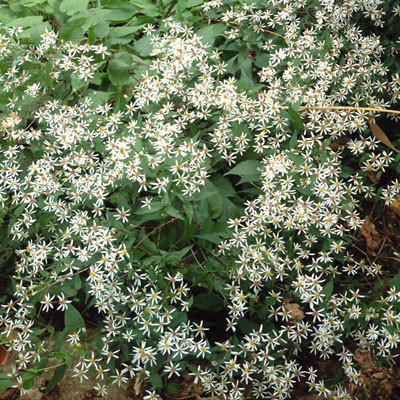

- Butterfly Friendly
- Bee Friendly
Potsize - 1L
Very simple starry flowers with widely spaced petals surrounding a yellow disc are artfully arranged along graceful thin black stems. Each time the stem divaricates (= splits in two, hence the name) a simple green leaf marks the break giving a simple elegance to the whole effect. This Aster is tolerant of quite dry shade without trouble which makes it very useful for illuminating a cool corner in Summer where the usual suspects for this environment are way past their best. Nice heart-shaped green leaves. Height 60cm, spreading habit. Discount of 25p per plant for quantities of 3 or overLinks
Aster Varieties Compared
Botanical Style Photographs
-

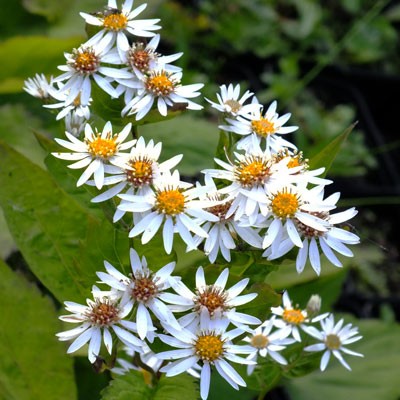
- Butterfly Friendly
- Bee Friendly
Potsize - 1L
Aster schreberi (Eurybia schreberi) is one of those plants that has a deserved reputation for excelling in dry shade where it will produce a gracefully arching mound covered in late Summer with 3.5cm white daisies with reflexed petals. The leaves are large serrated and stay fresh even in dry shade. 1-1.5m across. In many ways like a more beefy (some would say coarser) version of Aster divaricatus. Discount of 25p per plant for quantities of 3 or overLinks
Aster Varieties Compared
Botanical Style Photographs
-
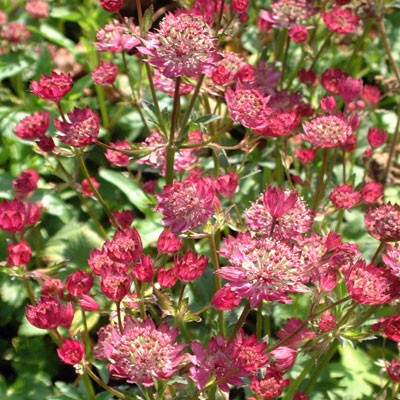
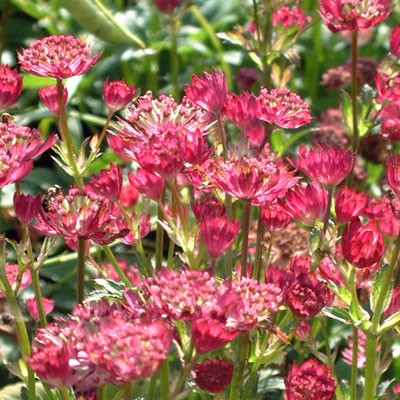
Potsize - 1L
A recently selected large flowered dark red masterwort. Tight clusters of maroon flowers are surrounded by beautiful ray florets. An interesting & beautiful plant happy in sun or part shade with some drainageLinks
Astrantia Compared
Astrantia in the Garden
Botanical Style Photographs
-
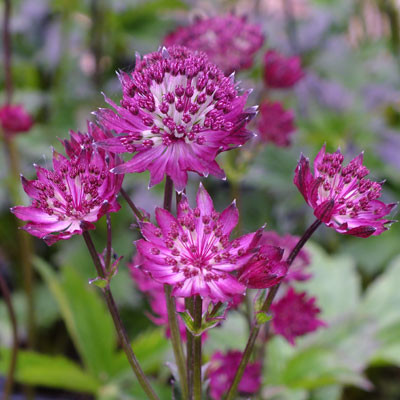
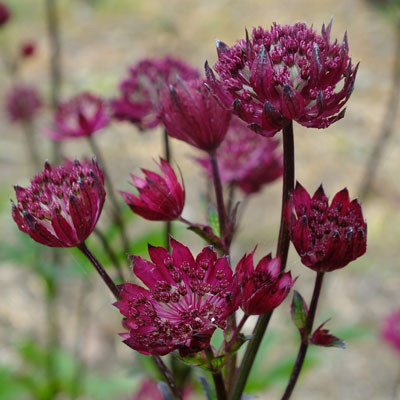
Potsize - 1L
We've seen it written that Astrantia 'Ruby Wedding' makes it inferior to some of the clonally propagated ones out there, but we've not found that the case at all. The ones we have are every bit as rich in colour as Ruby Wedding and Hadspen Blood. They don't have the dark staining leaves of the Gill Richardson Group, but for flower alone they are a lovely deep red with flowers of a very decent size. Ruby Wedding has its origins at the RHS Wisley where it was selected as a superior seedling in a sowing of Astrantia major subsp. major. Its bracts are of a good size and are strongly red to purple in hue. It is the parent of the seed strain known as Claret which may or may not live up to its parents reputation. It i svery similar to Hadspen Blood which has a similar bloodline but was selected by Nori Pope of Hadspen Gardens.Links
Astrantia Compared
Astrantia in the Garden
Botanical Style Photographs
-
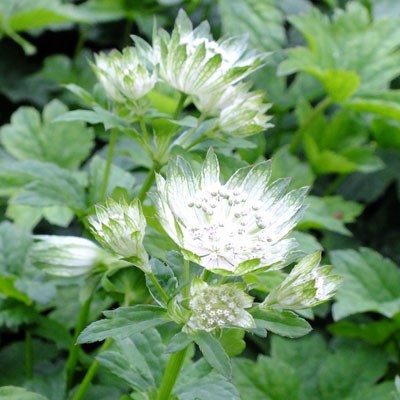
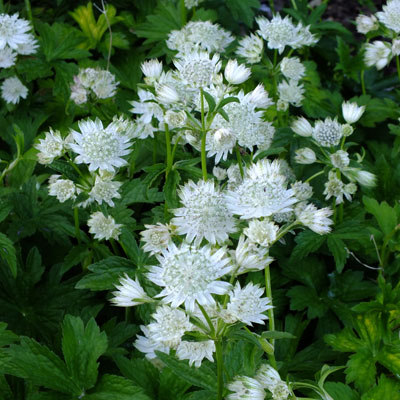
Potsize - 1L
A pure white, green-tipped, large flowered Astrantia from the 'Star' breeding program. We have examined this closely this year and it looks for all the world exactly like 'Shaggy', the excellent old variety selected by Margery Fish. It is a fine plant but we are as yet unsure why it merits its own name and PBR status.Links
Astrantia Compared
Astrantia in the Garden
Botanical Style Photographs
-
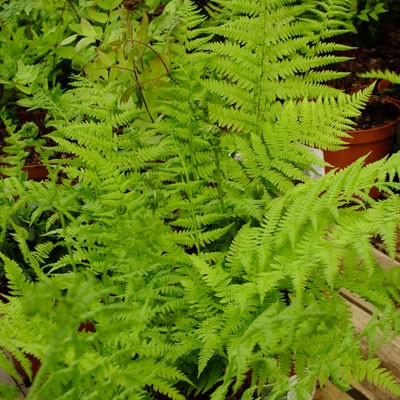
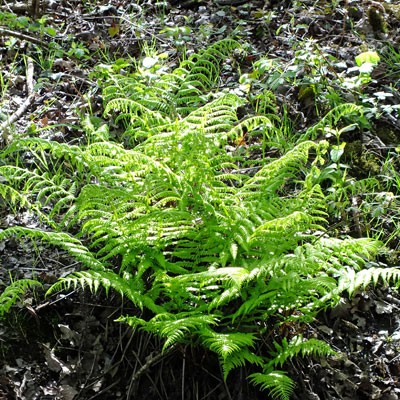
Potsize - 1L
This is the plain native form of Lady Fern, a plant that can be found throughout Britain growing in damp shady sites, but avoiding calcareous soils. It is an extremely hardy species and one that is quite variable from bipinnate to tripinnate sometimes. Whichever, it has a finer appearance than the Male fern and to my nose it is one of the 'ferniest smelling' of the ferns. It is fairly soon cut down with the onset of the frosts and is fully deciduous. Whilst a moist atmosphere is always an advantage and that coupled with a moist site will allow this fern to show of its best, once established they will actually tolerate quite dry sites, though with a cost on performance and leaf quality in dry spells.Discount of 25p per plant for quantities of 3 or overMore About Ferns
The Fern Order (Taxonomical List)
Botanical Style Photographs of Ferns
-
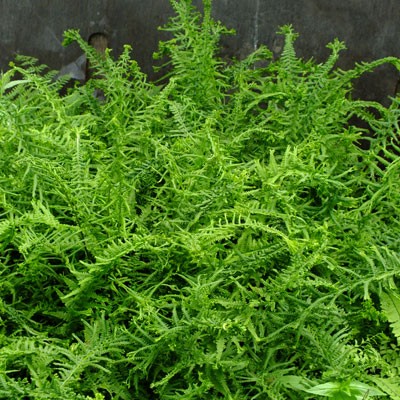
Potsize - 1L
This is the cruciate form of our native Lady fern. The leaves retain the lovely delicate nature of the species, but are distinguished in that alternate pinnae along the frond point either up or down from the plane of the leaf so that, were you to look down the length you could see a cross pattern. Often referred to as The Queen of the Ferns, it was a much treasured Victorian find. The tip of each pinna is also slightly crested which accentuates the overall frond outline. As with the native form, this is best in light shade with access to moisture at all times. grows to 90cm maybe a little more.Discount of 25p per plant for quantities of 3 or overMore About Ferns
The Fern Order (Taxonomical List)
Botanical Style Photographs of Ferns
-
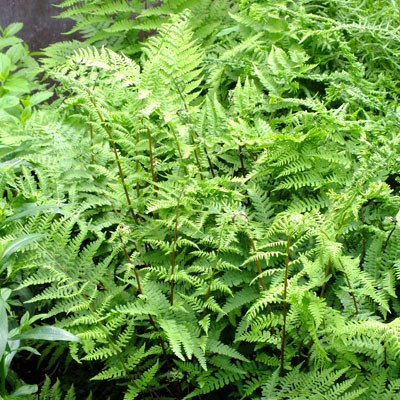
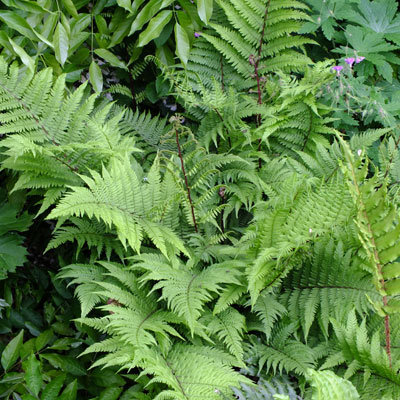

RHS AGM
Potsize - 1L
This is a selection of the North American form of our native Lady Fern which has stipes (frond stems) that are picked out in a rich ruby red. The full colouration is not apparent on young plants, but increases after plants have passed through their first frosty winter and then intensifies with age. Good nutrition will also intensify the colour. Overall the fronds are delicate in texture and posses that lovely 'ferny smell' when brushed. Needs constant access to moisture to grow at its best, achieving 90cm in height. Discovered in Vermont by John Lynch of the New England Wildflower Society.Discount of 25p per plant for quantities of 3 or overMore About Ferns
The Fern Order (Taxonomical List)
Botanical Style Photographs of Ferns
-
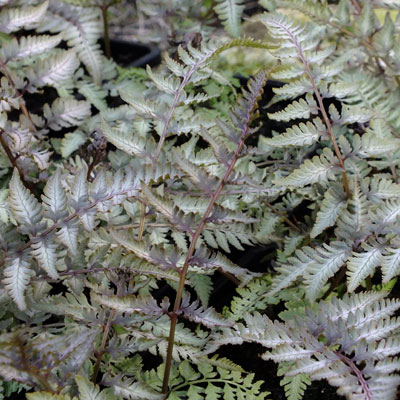
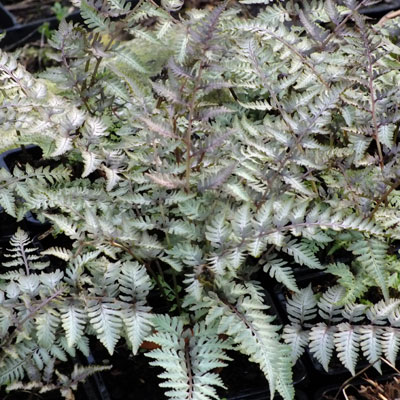
Potsize - 1L
Japanese Painted Fern. One of the many fine cultivars of this already lovely fern. Fronds are fine and delicate with a metallic silvery green sheen. Fronds are broad and grow fairly horizontally such that a plant will give good ground coverage when in leaf. A lovely fern worthy of a little care and a moist shady spot where it will prove most hardy. 45cm. DeciduousDiscount of 25p per plant for quantities of 3 or overMore About Ferns
The Fern Order (Taxonomical List)
Botanical Style Photographs of Ferns
-
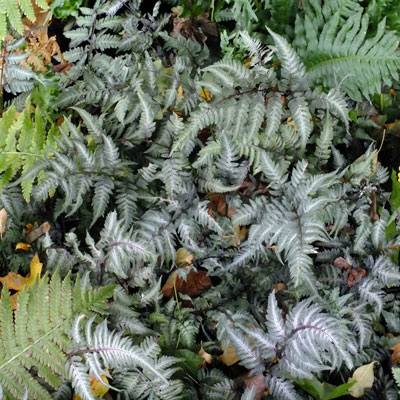
Potsize - 1L
Japanese Painted Fern. One of the many fine cultivars of this already lovely fern. Each frond begins the season green, ageing with a metallic silvery sheen which is further enhanced by rosy red etching and shading . Fronds are broad and grow fairly horizontally such that a plant will give good ground coverage when in leaf. A lovely fern worthy of a little care and a moist shady spot where it will prove most hardy. 45cm. DeciduousDiscount of 25p per plant for quantities of 3 or overMore About Ferns
The Fern Order (Taxonomical List)
Botanical Style Photographs of Ferns
-

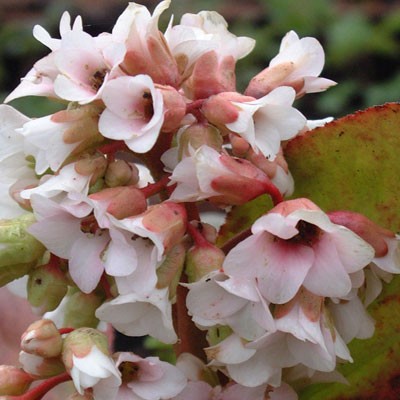
Potsize - 1L
Bergenia 'Bressingham White'. Praised for its robust stature and the freedom with which it produces both flower and leaf. Slowly spreading to form a good clump of large leaves with fine trusses of pure white flowers from March until May. Raised by Blooms and happy in both sun and part shade.Discount of 25p per plant for quantities of 3 or overLinks
Bergenia Compared
Botanical Style Photographs
-

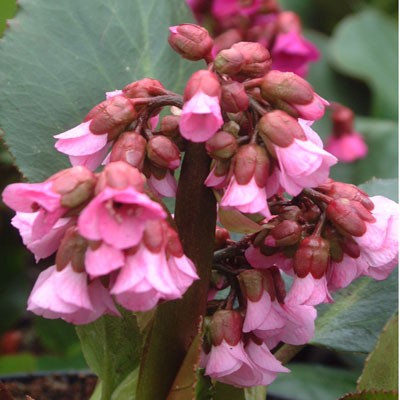
Potsize - 1L
Bergenia 'Eric Smith'. A handsome variety originally bred by Eric Smith at Hadspen House in Somerset and given to Beth Chatto who then named it in his honour. It has large, wavy edged crinkled leaves which take on plum and crimson tones in Winter. Sprays of bright mid-pink flowers top the foliage in Spring. Discount of 25p per plant for quantities of 3 or overLinks
Bergenia Compared
Botanical Style Photographs
-
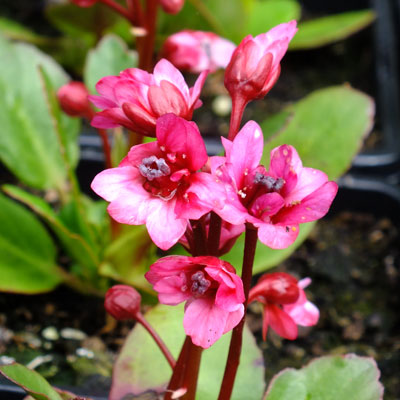

Potsize - 1L
This is a compact form of Bergenia but one that punches above its weight when it comes to flowering. Flowers are bright rosy-pink, carried on bright red stems and produced abundantly in March and April. Foliage is green for the growing season and turns deep beetroot in the Winter. 15-30cm tall. Discount of 25p per plant for quantities of 3 or overLinks
Bergenia Compared
Botanical Style Photographs
-
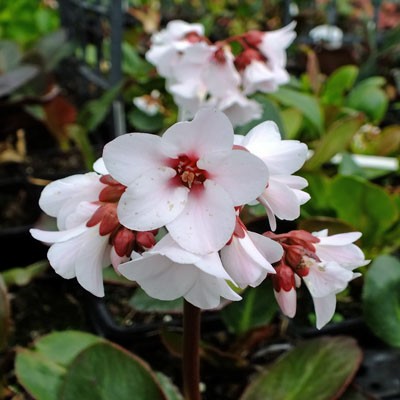

Potsize - 1L
An early flowering hybrid between B.ciliata and B.emeiensis nice, narrow, glossy green leaves, flushed red beneath and on the serrated margins. Like B.emiensis it has beautifully poised, shapely branched trusses of flowers, bell shaped at first becoming flared and wide separated with age. Also in common with B.emiensis its stems and calyxes are beautifully flushed with a pinky orange. The blooms are subtly shaded palest pink at first - just a suggestion of pink on a pure white, but as they age the central flush gradually grows until it is completely suffused rose-pink. A delightful but little known hybrid that requires a sheltered position away from the coldest winds. Bred by Robin White.Links
Bergenia Compared
Botanical Style Photographs
-
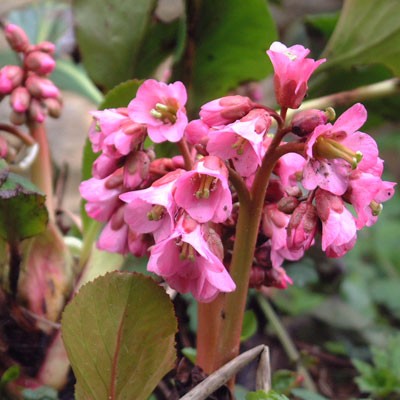
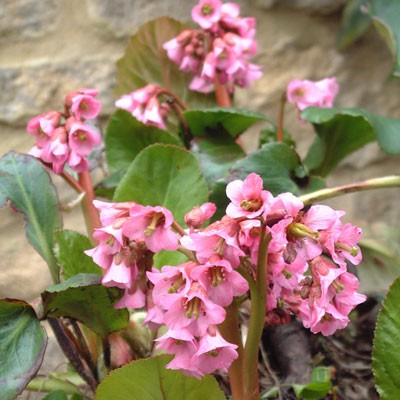
Potsize - 1L
Bergenia 'Silberlicht'. A relatively new addition to the Bergenia family having been raised in 1982 by H.Klose. It thrives in sun or shade even in quite dry conditions and produces valuable ground cover of handsome bronze tinted leaves. Its real beauty is shown when in flower late in the Spring. Flowering stems are tall and pink carrying flowers in a sugar pink hue. Discount of 25p per plant for quantities of 3 or overLinks
Bergenia Compared
Botanical Style Photographs
-
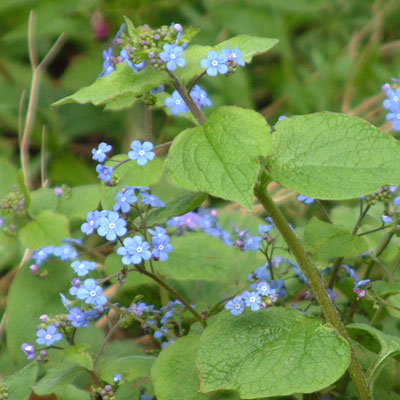
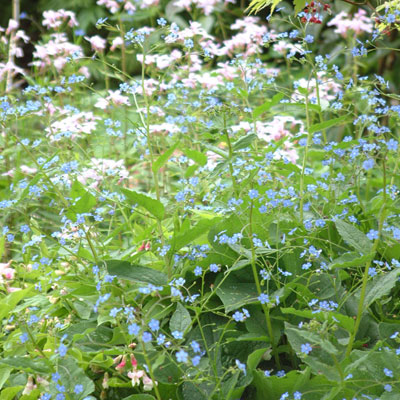
Potsize - 1L
Siberian Bugloss. A brilliant perennial which grows well in dry shady places, but will excel in most reasonable positions. Large heart-shaped felty green leaves make a stout clump topped in Spring with a cloud of tiny forget-me-not flowers. Hardy and reliable and one of those plants that ought to find a place in every garden. 30-45cmDiscount of 25p per plant for quantities of 3 or overLinks
Brunnera Compared
Botanical Style Photographs
-

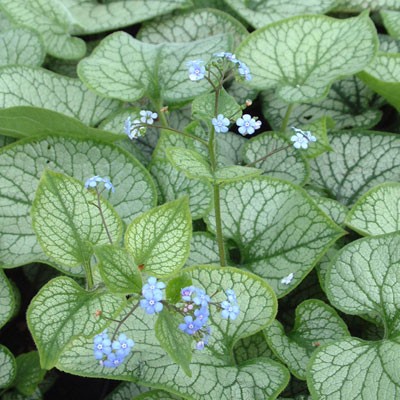

RHS AGM
Potsize - 1L
Brunnera macrophylla 'Jack Frost'. Coarsely hairy, heart-shaped leaves are heavily silvered and picked out by dark green margins and veins, making fascinating patterns not unlike an intricate cathedral window. A picture from Spring to Autumn especially when given shade and adequate moisture to prevent scorching in high Summer. The Spring display is further enhanced by an airy cloud of icy-blue forget-me-nots on stems decorated with smaller but similarly marked leaves. 50cmLinks
Brunnera Compared
Botanical Style Photographs
-
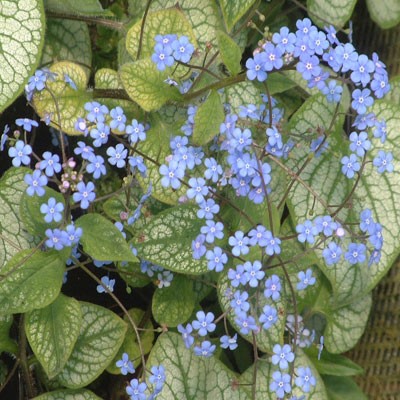
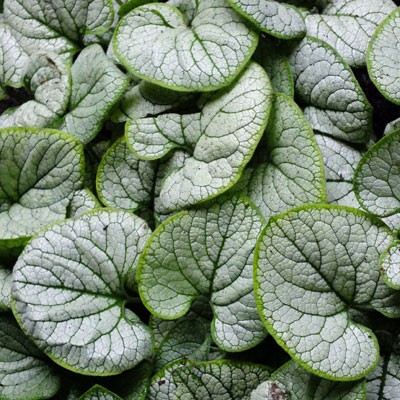
Potsize - 1L
Brunnera macrophylla 'Silver Heart'. A new introduction (2012) by Spilsbergen-Willemsen from the Netherlands. Superficially like a more silvered version of the popular Jack Frost, but generally considered to be a tougher more sun resistant variety on account of the thicker character of the leaves, which can also grow larger in size. Coarsely hairy, heart-shaped leaves are heavily silvered and picked out by dark green margins and veins, making fascinating patterns not unlike an intricate cathedral window. A picture from Spring to Autumn especially when given shade and adequate moisture to prevent scorching in high Summer. The Spring display is further enhanced by an airy cloud of icy-blue forget-me-nots on stems decorated with smaller but similarly marked leaves. 50cm plusLinks
Brunnera Compared
Botanical Style Photographs
-
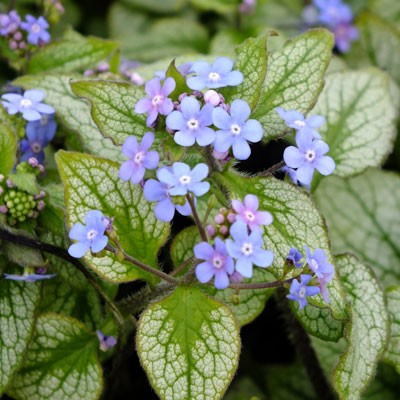
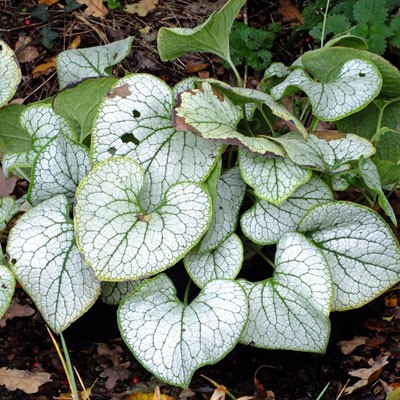
Potsize - 1L
Very similar to the ever popular Brunnera 'Jack Frost' except that it is a little whiter and has an elongated pointed tip to the leaf. Leaves are a lovely silver with the veins picked out in green forming a dense mound in any situation that is out of direct sun. Clouds of blue forget-me-not flowers in Spring.Links
Brunnera Compared
Botanical Style Photographs
-

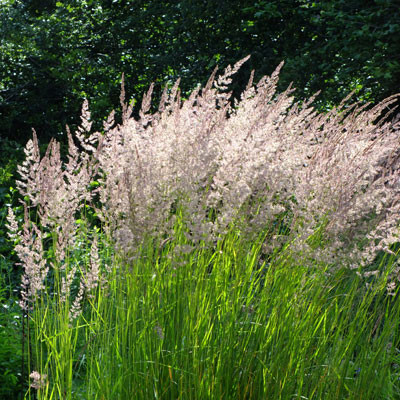
Potsize - 1L
Feather Reed Grass. This fine variety was named after the distinguished German nurseryman Karl Foerster (1874-1970) who selected and introduced it. It is a sterile hybrid (C.arundinacea x C.epigejos) and forms a narrow column, 60cm high in leaf and 150cm plus in flower. The flower spikes are narrow feathery plumes, purpley green to start, ageing a lovely golden shade in Autumn and persisting well into the Winter. It will tolerate a wide range of soils, including heavy clay and compacted soils and whilst it prefers a sunny drier site, it will tolerate a wet site well. The first grass to win Perennial Plant of the Year, which it did in 2001Discount of 25p per plant for quantities of 3 or over -

Potsize - 9cm
Convallaria majalis. Lily-of-the-Valley. One of those perennials that really needs no introduction. It is native to Britain and is particularly common on Lime rich soils, growing thick tangled mats of root in woodland situations. Each node produces two broad leaves in the middle of which nestle the stiff little spikes hung on One side with little fragrant white bells, Each with a narrowed frilly opening like an old-fashioned maids bonnet. Lily-of-the-Valley is easily grown and adaptable and particularly suited to leaving alone in difficult dry situations where It will happily carpet and provide fragrant little posies Each SpringDiscount of 25p per plant for quantities of 3 or overLinks
Lily-of-the-Valley - Botanical Style Photographs
-

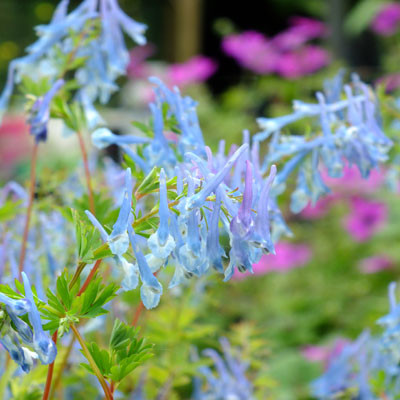
Potsize - 1L
A cross between Corydalis fleuosa and Corydalis omeniana from Ian Young's garden in Aberdeen. Vigorous clumps of limey, chartreusy-green juicy fern-like foliage over which come the strongly scented sky-blue flowers. Like Corydalis elata, but smaller and colouring only very slightly in the stems. Wintergreen and very hardy if grown in a moisture retentive soil which is not over wet and doesn't dry out in the Summer. Divide every three years to maintain vigour and encourage the best flowering. Flowers from Spring until June. 30cmLinks
Corydalis Compared
-

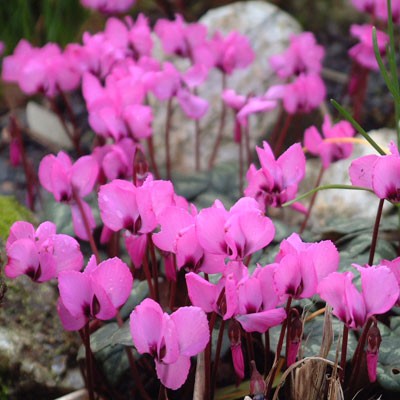
Potsize - 3.5 inch round
Cyclamen coum is the other cyclamen commonly grown out of doors in Britain. It is a little fussier than Cyclamen hederifolium but essentially requires quick drainage, good winter light with a little shade in the hottest part of the day come Spring and shelter from cold drying winds. It is very hardy but dislikes freezing or wet winds. Its marbled kidney-shaped leaves appear in September and persist until late Spring when higher temperatures and sunlight force the into a protective dormancy. The flowers are more dumpy and rounded than typical cyclamen flowers and come in a range of colours from white through pink to deep magenta, always with a darker blotch at the mouth of the paler eyes. They liven up the Winter garden, appearing as they do from Christmas onwards, being remarkably cold tolerant. Excellent for naturalising in sunny banks at the foot of trees, even conifers providing the branches don't come too close to the ground. They only require good drainage, some shelter and a little shade in late Spring which can be provided by deciduous shrubs and tress or even herbaceous plants or bulbs. Discount of 25p for 3-9 plants, 30p for 10 or more Our plants have been grown from seed collected around the garden and are therefore various shades and have varied leaf patterns. They are not wild collectedLinks
Botanical Style Photographs
-

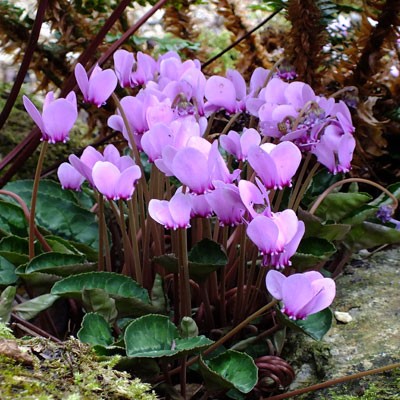
Potsize - 3.5 inch round
Cyclamen hederifolium heralds the onset of Autumn when its charming pink or white reflexed flowers push their way above ground in late August. Cyclamen hederifolium is the easiest species to grow as it will withstand extreme cold and frozen conditions but also high summer temperatures when it is protected by its dormancy. They thrive in poor soil, make good companions to bulbs and will thrive anywhere that offers quick drainage and reasonable light (not overshadowed) when in leaf through Winter. The leaves make wonderful ground cover in many situations but especially in difficult dry areas under trees. They have wonderful marbled patterns and form close knit mats of thick textured ivy-shaped leaves, often with lovely purply reverses. The leaves arrive shortly after the flowers (in September) and persist through the dullest months until Summer heat drives them into dormancy. Discount of 25p for 3-9 plants, 30p for 10 or more Our plants are grown from seed collected from a variety of plants in the garden, (they are not collected from the wild), and are therefore a mixture of leaf patterns and flower colours.Links
Botanical Style Photographs
-

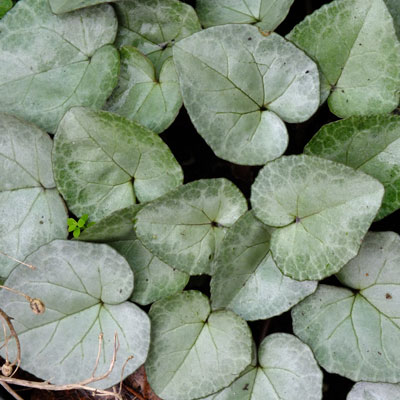
Potsize - 1Litre
This lovely group covers forms with a fully silvered leaf. Just as easy as the more commonly encountered green leaf varieties just with more striking foliage. Flowers are pale pink with a darker eye, occasionally white. Excellent to grow in a shady dry spot where the foliage makes excellent ground cover.Links
Botanical Style Photographs
-

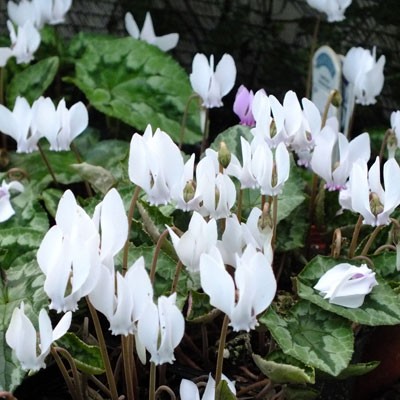
Potsize - 3.5 inch round
These are plants we have selected out from the main batch which we know are pure white. Cyclamen hederifolium heralds the onset of Autumn when its charming pink or white reflexed flowers push their way above ground in late August. Cyclamen hederifolium is the easiest species to grow as it will withstand extreme cold and frozen conditions but also high summer temperatures when it is protected by its dormancy. They thrive in poor soil, make good companions to bulbs and will thrive anywhere that offers quick drainage and reasonable light (not overshadowed) when in leaf through Winter. The leaves make wonderful ground cover in many situations but especially in difficult dry areas under trees. They have wonderful marbled patterns and form close knit mats of thick textured ivy-shaped leaves, often with lovely purply reverses. The leaves arrive shortly after the flowers (in September) and persist through the dullest months until Summer heat drives them into dormancy. Discount of 25p for 3-9 plants, 30p for 10 or more Our plants are grown from seed collected from a variety of plants in the garden, (they are not collected from the wild), and are therefore contain a mixture of leaf patterns.Links
Botanical Style Photographs
-
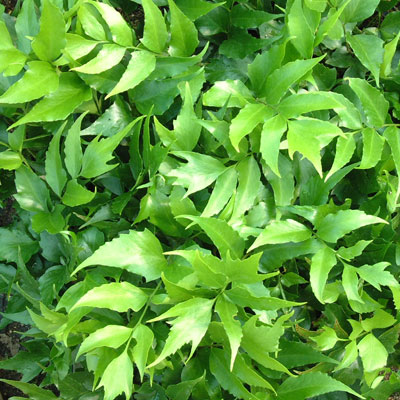
Potsize - 1L
The deep glossy forest green fronds of this fern with its broadly pinnate pseudo-holly foliage makes a wonderful focal point amongst its lacy cousins or a fine evergreen for shade in its own right. It grows to 75cm (30") and can look handsome all year, especially if protected from bitter winds. Good even in deep shade given woodsy friable soil. It will burn if grown in full sun. native of Asia (Korea, China, Vietnam and Thailand and especially Japan where it makes its home in a wide range of environments from urban walls to forest floors.Discount of 25p per plant for quantities of 3 or overLinks
Ferns - Garden Pictures
Ferns for Moist Sites
Ferns for Dry Sites
Ferns - Deciduous or Evergreen
-
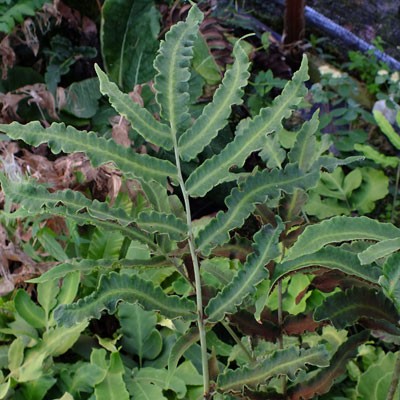
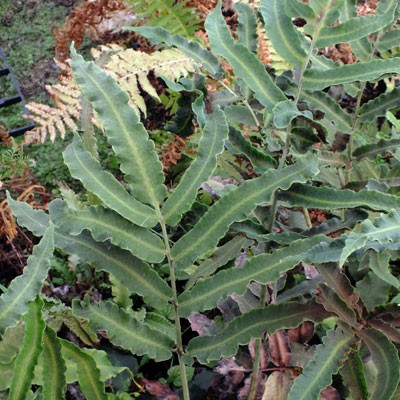
Potsize - 1L
A most unusual fern with magnificent and oddly shaped fronds that mark it out as quite distinct from any other Dryopteris. The leaves have a leathery quality with 2-5 pairs of broad pinnae and a long pointed terminal pinnule. (a further subdivision of the primary leaflets, known as the pinnae). It requires adequate moisture and a sheltered position as it is not bone-hardy in every Winter (covering the crown would help greatly in very cold Winters). In a choice position it can remain evergreen, but it will become deciduous as a protective measure against the cold. Use the old fronds as protection for the crown. It is slow to bulk up and propagate but well worth the wait. fronds eventually get 20-50 by 20-35cm and the rhizome will gradually creep. From japan and Taiwan. Zone 8, which includes most of England and Wales and the West coast of Scotland.Links
Ferns - Garden Pictures
Ferns for Moist Sites
Ferns for Dry Sites
Ferns - Deciduous or Evergreen
Botanical Style Photographs
-
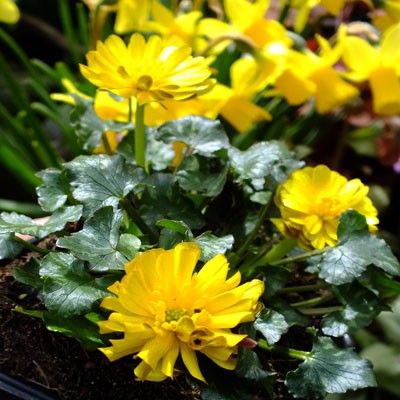
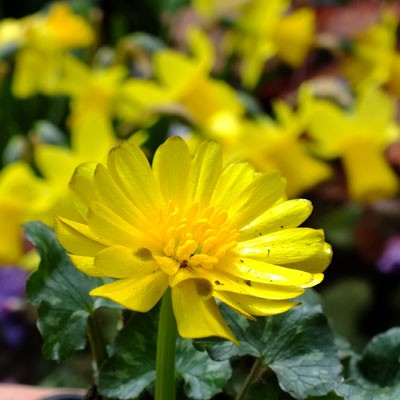
Potsize - 9cm
Lesser Celandine. Gold-edged, bronze buds open to a typical celandine colour, the difference being that Ficaria verna 'Montacute' (Ranunculus ficaria) has 4 ruffs of petals, prettily incurved to reveal the contrasting bronzy reverse. The petals are neatly square-ended, almost as if they have been trimmed. Unlike 'Flore Pleno' the centres of the flowers are open revealing a green eye surrounded by a boss of orange anthers. The leaves are arrow shaped, green flecked with silver. A favourite of mine and one of the earliest to flower. Said to have been rescued from a verge in Montacute, Somerset in 1994 just prior to being destroyed in roadworks. -
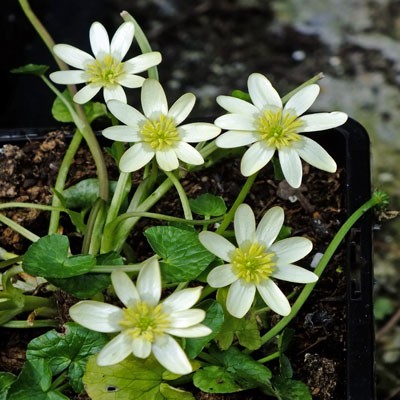
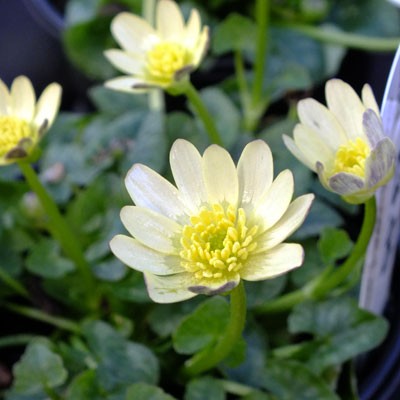
Potsize - 9cm
Lesser Celandine. Glossy Buttermilk petals, shaded purplish on the reverse set off by a central boss of double-cream stamens. A nice contrast to the other cultivars or where the bold yellows are a bit too strident. Plain green leaves. This selection comes from Allan Robinson, former Rock Garden Superintendent at Wisley, who named it after his cat. -

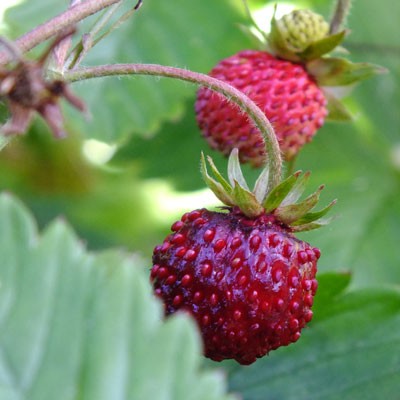
Potsize - 9cm
Fragaria vesca, commonly called wild strawberry, woodland strawberry, Alpine strawberry, Carpathian Strawberry, European strawberry, or fraisier des bois. This is our native strawberry. Much smaller than the cultivated varieties with a very running habit. It grows really well in shade where it will produce a steady supply of its really intensely flavoured small fruit. Great for growing somewhere where it can just run wild and free. Discount of 25p per plant for quantities of 10 or over. -

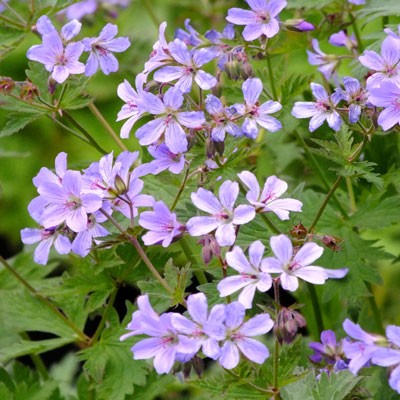
Potsize - 1L
(Geranium albiflorum x Geranium sylvaticum) I was drawn to this delicate geranium as it was so different from its cousins. It has small lustrous mauve flowers, 1cm wide with petals quite widely spaced. It has a lovely little curly puce pink style and flushes of magenta bee-lines. It really comes into its own when established and flowering en masse when the effect is quite charming. 45-90cm. An Alan Bremner cross. Discount of 25p per plant for quantities of 3 or overLinks
Geranium Compared
Geranium in the Garden
Botanical Style Photographs
-
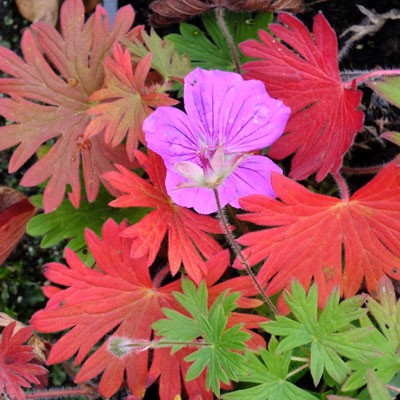

Potsize - 1L
Geranium 'Tiny Monster'. (Geranium psilostemon x Geranium ‘Ankum’s Pride’) This cultivar has the benefit of a growth habit and leaf like a G.sanguineum, but with flowers on branching flower stems. It is long flowering with large flowers for its size, each Purplish red with darker veins. Leaves redden well in the Autumn. Raised by Rolf Offenthal at Grethem, Germany. Discount of 25p per plant for quantities of 3 or overLinks
Geranium Compared
Geranium in the Garden
Botanical Style Photographs
-
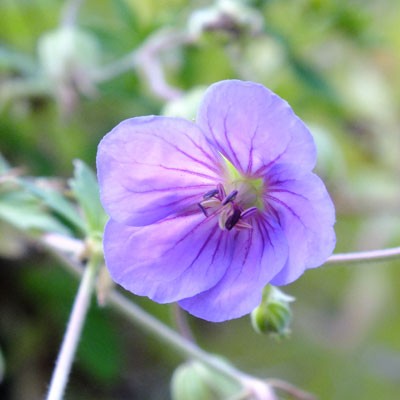


RHS AGM
Potsize - 1L
(syn. Geranium 'Verguld Saffier') This variety is a cross between 'Ann Folkard' and wallichianum 'Buxton's variety', inheriting characteristics of both. It has the yellow leaves of the former, longer lasting than the parent, with flowers in a pinky-blue produced all throughout the summer. Its AGM says it is undoubtedly a good cultivar, but anyone who knows me, knows my thoughts on plants that pair yellow leaves and pink flowers so I'll shut up now. It has a low growing, sprawling habit, making it ideal for the front of the border. It is a little smaller than 'Ann Folkard'. It is reliable, but likes some shade to do its best. Originally found as a seedling in Hans Kramer's de Hessenhof nursery in about. 1994 40 X 110cm Discount of 25p per plant for quantities of 3 or overLinks
Geranium Compared
Geranium in the Garden
Botanical Style Photographs
-
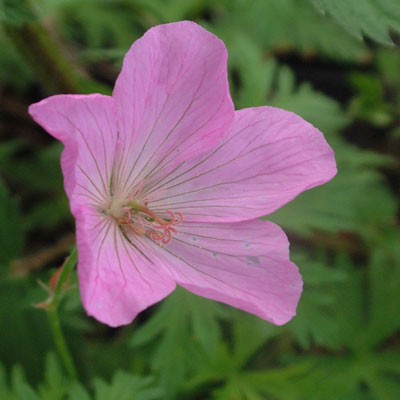
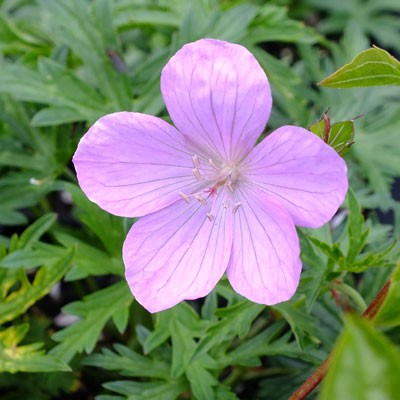
Potsize - 1L
The flowers of Geranium 'Kashmir Pink' are particularly nicely shaped with petals in a clear rosy baby-pink. Each has translucent veins and paler, almost green eye. Combined with the very fine foliage, this is a Geranium of very fine overall effect . Raised by Robin White of Blackthorn Nursery, a seedling from 'Kashmir Purple'.Links
Geranium Compared
Geranium in the Garden
Botanical Style Photographs
-
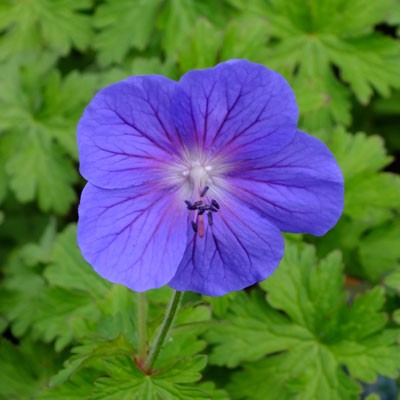
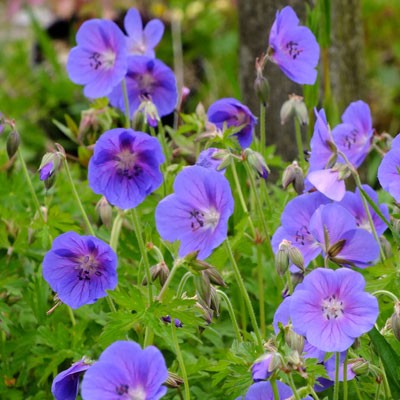
Potsize - 1L
Geranium himalayense 'Gravetye'. Large saucer-shaped blooms in a strong violet-blue are held well above the attractive foliage. 'Gravetye', selected from the garden of William Robinson, has flowers with a particularly pronounced central purplish flush on a more compact plant than the species. The species is a Himalayan plant that forms dense clumps of well cut foliage. Flowers April to July. Excellent red Autumn colour. Discount of 25p per plant for quantities of 3 or overLinks
Geranium Compared
Geranium in the Garden
Botanical Style Photographs

















































